Related Research Articles

Marvel Comics is an American comic book publisher and primary imprint of Marvel Worldwide Inc., part of Marvel Entertainment. In 2009, The Walt Disney Company acquired the parent company.

An American comic book is a thin periodical originating in the United States, on average 32 pages, containing comics. While the form originated in 1933, American comic books first gained popularity after the 1938 publication of Action Comics, which included the debut of the superhero Superman. This was followed by a superhero boom that lasted until the end of World War II. After the war, while superheroes were marginalized, the comic book industry rapidly expanded and genres such as horror, crime, science fiction and romance became popular. The 1950s saw a gradual decline, due to a shift away from print media in the wake of television and the impact of the Comics Code Authority. The late 1950s and the 1960s saw a superhero revival and superheroes remained the dominant character archetype throughout the late 20th century into the 21st century.

A newsagent's shop or simply newsagent's or paper shop, newsagency or newsstand is a business that sells newspapers, magazines, cigarettes, snacks and often items of local interest. In Great Britain, Ireland and Australia, these businesses are termed newsagents. Newsagents typically operate in busy public places like city streets, railway stations and airports. Racks for newspapers and magazines can also be found in convenience stores, bookstores and supermarkets. The physical establishment can be either freestanding or part of a larger structure.
Diamond Comic Distributors, Inc. is an American comic book distributor serving retailers in North America and worldwide. They transport comic books and graphic novels, as well as other popular culture products such as toys, games, and apparel from comic book publishers or suppliers to retailers. Diamond distributes to the direct market in the United States and has exclusive distribution arrangements with several major U.S. comic book publishers, including Dark Horse Comics, Image Comics, and IDW Publishing.

Pacific Comics (PC) was an American comic book publisher that was active from 1981 to 1984. It was also a chain of comics shops and a distributor. It began at a San Diego, California, comic book shop owned by brothers Bill and Steve Schanes. Along with competitors like First Comics and Eclipse Comics, PC took early advantage of the growing direct market, attracting a number of writers and artists from DC and Marvel to produce creator-owned titles, which were not subject to the Comics Code, and thus were free to feature more mature content.
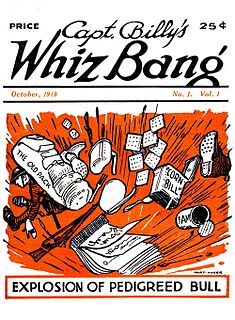
Fawcett Publications was an American publishing company founded in 1919 in Robbinsdale, Minnesota by Wilford Hamilton "Captain Billy" Fawcett (1885–1940).

Trident Comics was a comic book publishing company based in Leicester, UK, specialising in black and white comics created by new British talent. It was formed in 1989 as an offshoot of the comics distributor/wholesaler Neptune Distribution, and went out of business in 1992 when Neptune was acquired by a competitor.

Atlas Comics is the 1950s comic-book publishing label that evolved into Marvel Comics. Magazine and paperback novel publisher Martin Goodman, whose business strategy involved having a multitude of corporate entities, used Atlas as the umbrella name for his comic-book division during this time. Atlas evolved out of Goodman's 1940s comic-book division, Timely Comics, and was located on the 14th floor of the Empire State Building. This company is distinct from the 1970s comic-book company, also founded by Goodman, that is known as Atlas/Seaboard Comics.
Martin Goodman was an American publisher of pulp magazines, paperback books, men's adventure magazines, and comic books, launching the company that would become Marvel Comics.
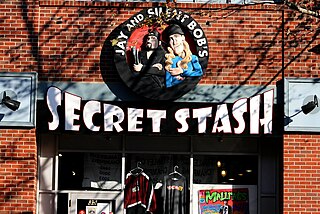
The direct market is the dominant distribution and retail network for American comic books. The concept of the direct market was created in the 1970s by Phil Seuling. The network currently consists of:
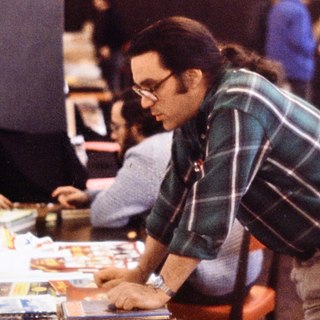
Philip Nicholas Seuling was a comic book fan convention organizer and comics distributor primarily active in the 1970s. Seuling was the organizer of the annual New York Comic Art Convention, originally held in New York City every July 4 weekend throughout the 1970s. Later, with his Sea Gate Distributors company, Seuling developed the concept of the direct market distribution system for getting comics directly into comic book specialty shops, bypassing the then established newspaper/magazine distributor method, where no choices of title, quantity, or delivery directions were permitted.
Nick Landau is a British media figure. He is co-owner of the Titan Entertainment Group, which publishes Titan Magazines and Titan Books, and owns the London Forbidden Planet store. In the 1970s, before starting up Titan Distributors, he published a fanzine, organized comic marts and comic book conventions, imported American comics into the UK, and even spent part of a year as an editor with 2000 AD.
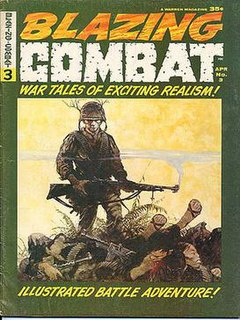
Blazing Combat was an American war-comics magazine published quarterly by Warren Publishing from 1965 to 1966. Written and edited by Archie Goodwin, with artwork by such industry notables as Gene Colan, Frank Frazetta, John Severin, Alex Toth, and Wally Wood, it featured war stories in both contemporary and period settings, unified by a humanistic theme of the personal costs of war, rather than by traditional men's-adventure motifs.
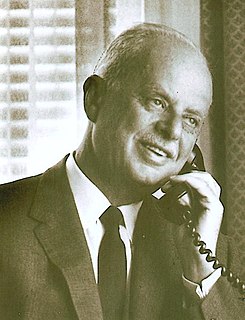
Jacob S. Liebowitz was an American accountant and publisher, known primarily as the co-owner with Harry Donenfeld of National Allied Publications.

Stephen A. Geppi is an American comic book distributor, publisher and former comic store owner. Having established an early chain of comic shops in Baltimore in the mid-late 1970s, he is best known for his distributing business. Geppi founded Diamond Comic Distributors, the largest comic direct distribution service in 1982, and has served as the company's head to the present. Diamond Distribution became the successor to direct market pioneer Phil Seuling's distribution dream when Geppi took over New Media/Irjax's warehouses in 1982. He further bought out early-distributor Bud Plant in 1988, and main rival Capital City in 1996 to assume a near-monopoly on comics distribution, including exclusivity deals with the major comic book publishers.
Big Rapids Distribution was a Detroit-based distributor focusing on underground newspapers, radical literature, and underground comix. They were responsible for the unusually good coverage that underground comix and underground papers got in the Michigan area in the early 1970s, when they could be found in most full-service newsstands there. At its height, shortly before it went bankrupt in 1980, Big Rapids was functioning as an alternative independent distributor in the central and southern Michigan areas, selling a full line of magazines and paperbacks, as well as mainstream comics.
Capital City Distribution was a Madison, Wisconsin-based comic book distributor which operated from 1980 to 1996 when they were acquired by rival Diamond Comic Distributors. Under the name Capital Comics, they also published comics from 1981 to 1984.
New Media Distribution/Irjax Enterprises was a comic book distributor and publisher active from the mid-1970s to the mid-1980s. In 1978, the company's legal actions against the dominant distributor of the era, Sea Gate Distributors, widened the field for the direct market to expand. In 1982, when Irjax's distribution arm went out of business, its processing centers and warehouses formed the basis for Diamond Comics Distributors, the now-dominant comics distributor. The company's publishing arm, New Media, continued in the business until 1995. New Media mainly published periodicals for comics/fantasy/science fiction enthusiasts, including the long-running critical journal Comics Feature. Editors and writers with New Media included Carol Kalish, Richard Howell, Peter B. Gillis, Kurt Busiek, Don and Maggie Thompson, James Van Hise, Peter Sanderson, Max Allan Collins, Ron Goulart, Will Jacobs and Gerard Jones, Steve Perrin, and Roy Thomas.
Independent News Co. was a magazine and comic book distribution business owned by National Periodical Publications, the parent company of DC Comics. Independent News distributed all DC publications, as well as those of a few rival publishers, such as Marvel Comics from 1957 to 1969, in addition to pulp and popular magazines. The company was founded in 1932 and operated until c. 1970.

Louis Horace Silberkleit was an American publisher of magazines, books, and comic books; together with Maurice Coyne and John L. Goldwater, he co-founded MLJ Magazines, and served as its publisher for many years.
References
- Ashley, Mike (2005). Transformations: The Story of the Science Fiction Magazines from 1950 to 1970 . Liverpool: Liverpool University Press. ISBN 0-85323-779-4.
- Vadeboncoeur, Jim (based on a story uncovered by Brad Elliott). "The Great Atlas Implosion," The Jack Kirby Collector #18 (Jan. 1998) pp. 4–7.